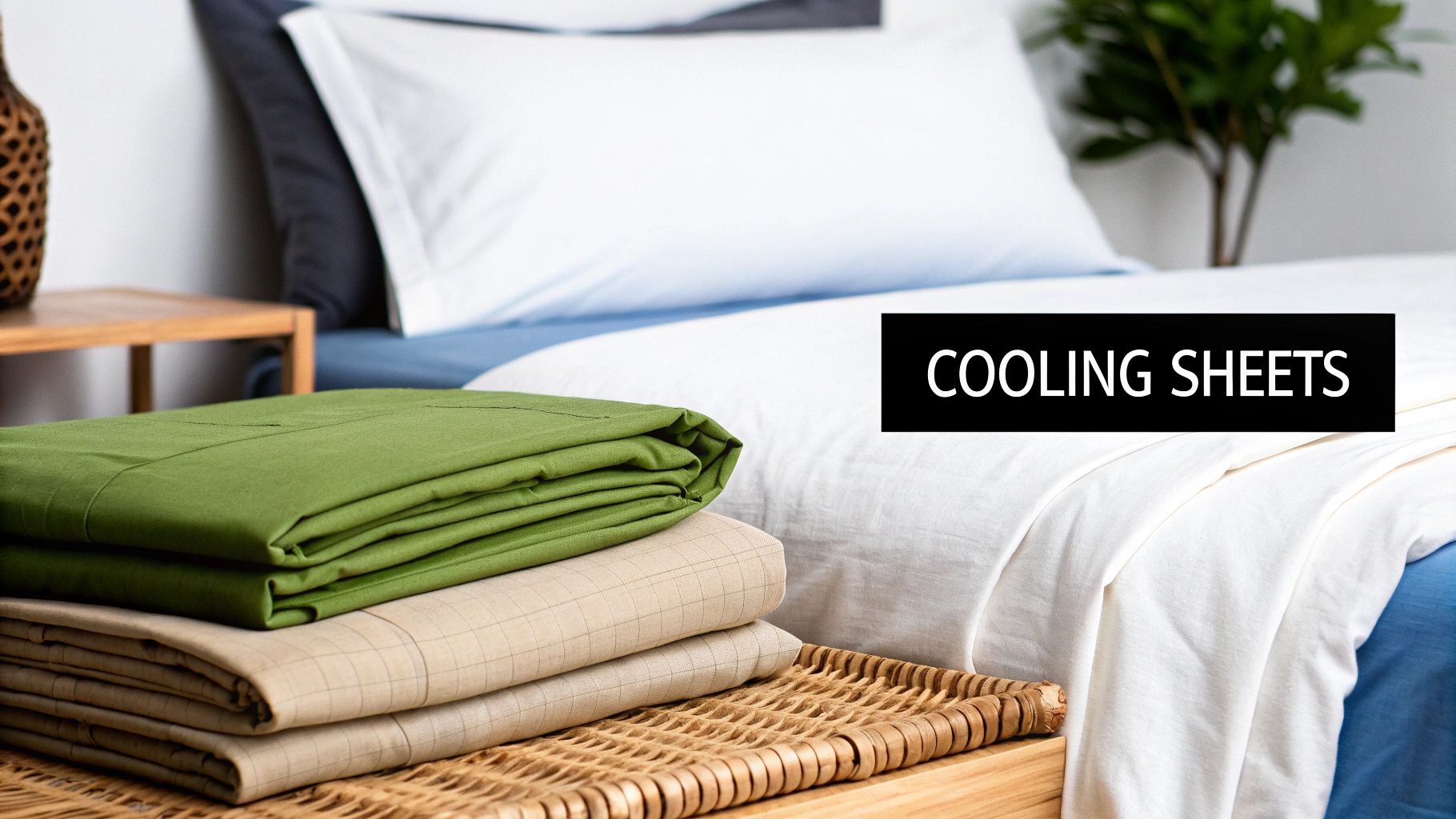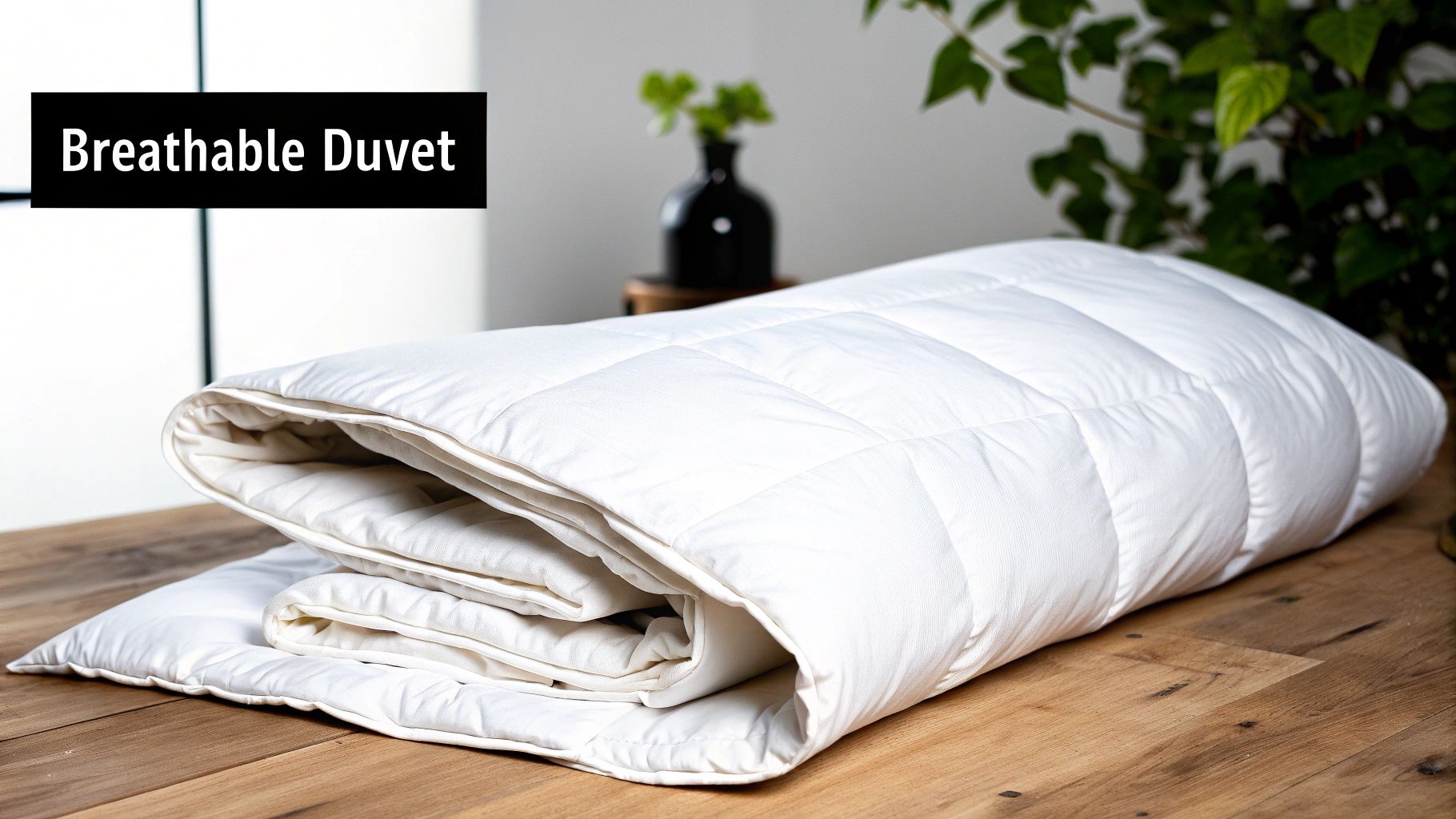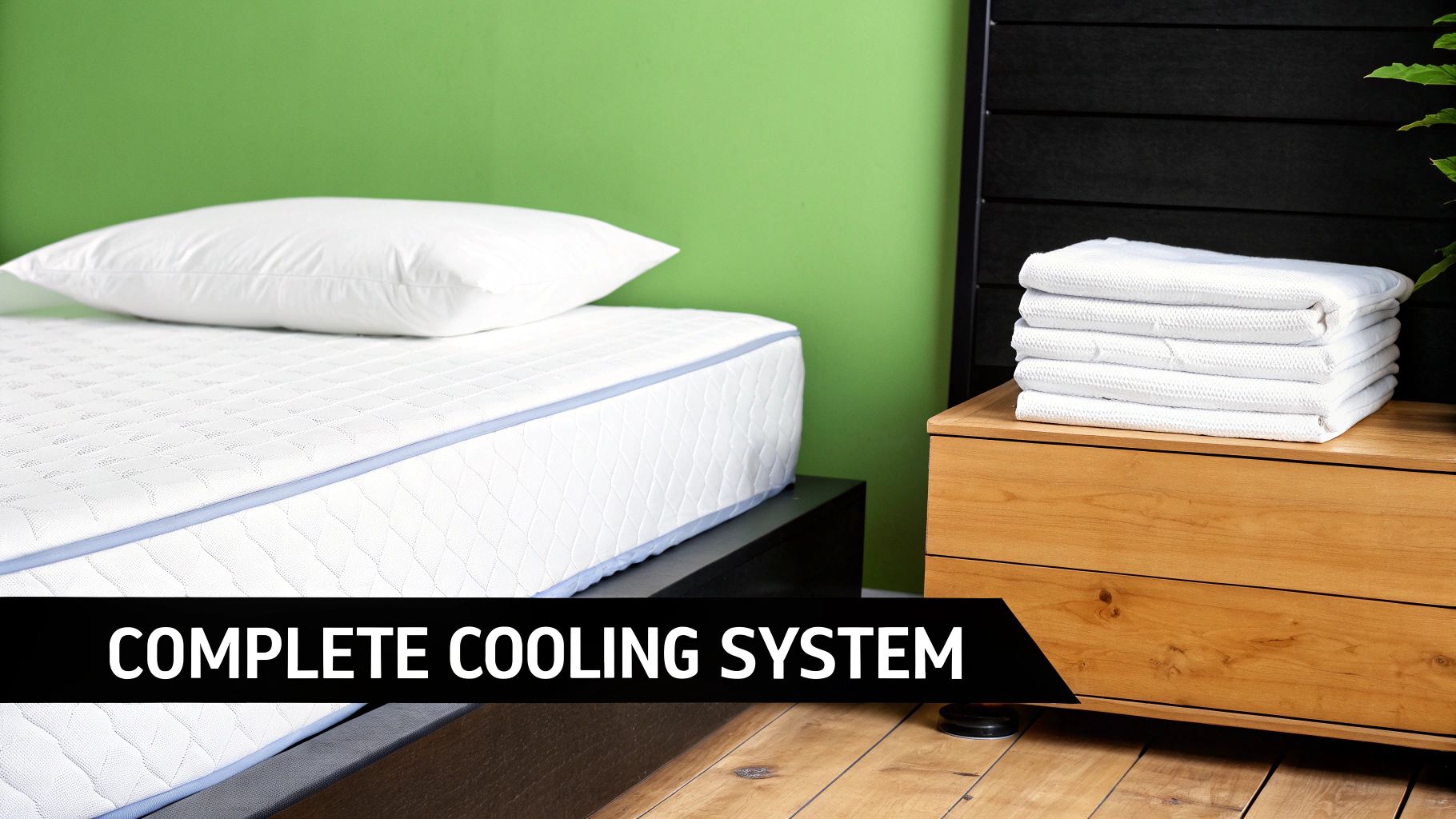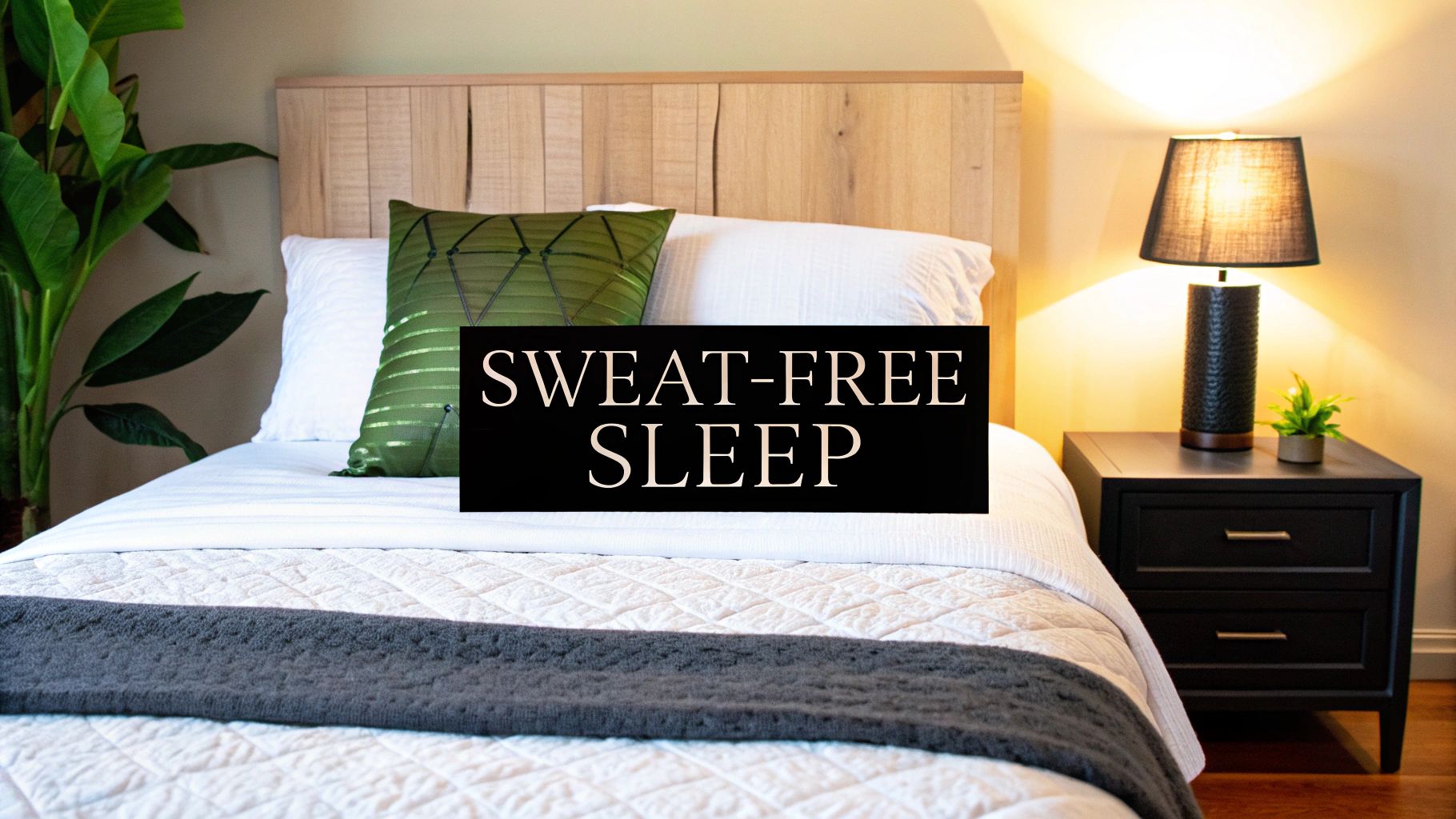If you are struggling with night sweats, the right bedding can be a game changer. Natural, breathable fabrics like linen, bamboo, or Tencel™ are fantastic at drawing moisture away from your skin and letting air flow freely, keeping you cool and dry all night. Combine these with a lightweight, temperature regulating duvet, perhaps filled with wool or silk, and you will create a sleep environment that works with your body, not against it.
Finding Your Solution to Sweaty Nights
Waking up feeling damp and sticky is a miserable way to start the day. It is a frustratingly common problem, but the good news is that your bedding can make a world of difference. This is not about some miracle cure; it is about making smart choices with materials that help your body regulate its own temperature naturally. Let us cut through the jargon and get straight to what actually works for a cool, dry night's sleep.
This guide is here to help you understand why certain fabrics are so much better at handling heat and moisture. Many people are surprised to learn that their supposedly luxurious, high thread count sheets could be part of the problem, trapping heat and humidity right next to their skin. We will explore the wonderfully breathable alternatives that promote proper airflow and keep you comfortable.
Understanding the Causes and Seeking Solutions
Night sweats are more than just a minor annoyance, they can seriously disrupt your sleep quality. It is an issue that affects a huge number of people, especially women. For instance, in the UK, it is reported that 78% of women aged 54 to 65 experience night sweats during their menopausal transition.
This widespread problem has led many to actively search for better solutions. A recent survey found that 42% of women dealing with this had bought new bedding in the last year, with most specifically looking for products marketed as ‘cooling’. You can explore more about the effects of menopause and how it impacts sleep.
What to Expect from This Guide
We are going to cover everything you need to know to make an informed choice. Think of this as your roadmap to building a better bed, one piece at a time. We will look at:
- Breathable Fabrics: We will dive into why materials like linen, bamboo, and Tencel are the champions of coolness and moisture wicking.
- Smart Duvet Fillings: You will learn how natural fills like wool can help regulate your body temperature, keeping you just right in any season.
- The Complete System: We will also cover how pillows and mattress protectors play a crucial role in creating an overall cooler sleep experience.
By the time you are done, you will feel confident about what to look for. You will be empowered to create a sleep sanctuary that finally puts an end to those uncomfortable, sweaty nights for good.
Why Your Bedding Might Be Making You Sweat
Have you ever considered that your wonderfully cosy duvet might be the secret culprit behind your sweaty nights? It is a thought that crosses many minds, and for good reason. A lot of popular bedding materials, especially synthetics like polyester or microfibre, are notorious for poor airflow.
Think of it like sleeping under a plastic sheet. These fabrics trap your body heat and any moisture right against your skin, creating a warm, humid microclimate under the covers. In response, your body sweats even more in an effort to cool down, creating a frustrating cycle that ruins a good night's rest.
Even some so called luxury options can backfire. Sheets with an extremely high thread count, while feeling silky smooth, are often woven so densely that they stifle air circulation, making the problem of overheating even worse.
How Your Bedding Traps Heat
The materials you surround yourself with at night play a massive role in your body's ability to regulate its temperature. When fabrics are not breathable, they prevent heat from escaping and stop sweat from evaporating, and evaporation is your body's primary cooling mechanism.
When your bedding restricts airflow and fails to wick away moisture, your body has to work much harder to cool itself down. This is often the main trigger for waking up overheated and uncomfortable, even in a cool room.
Choosing the right material is the first and most powerful step you can take towards a drier, more comfortable sleep. This simple decision tree really highlights how crucial that initial choice of breathable bedding is.

As the infographic makes clear, the path to comfort begins with breathable fabrics. We will get into the best options shortly, but first, it is essential to understand the differences between materials. If you are curious about two of the most popular natural choices, you can explore the benefits of linen vs cotton in our detailed comparison. It is a great way to see why one often has the edge when it comes to managing moisture.
Choosing Sheets That Keep You Cool and Dry

The secret to a comfortable night’s sleep is not just how cool your sheets feel when you first slip into bed. The real test comes down to how well they manage moisture when you start to warm up. This is where a fabric's wicking ability comes into play, and for anyone who deals with night sweats, it is a total game changer.
Think of wicking fabrics as a smart transport system for sweat. Instead of just soaking it up and becoming damp, they actively pull moisture away from your skin and disperse it across the surface of the material. This helps it evaporate much faster, keeping you feeling dry and comfortable, not sticky.
Let us take a look at the materials that really excel at this.
Classic Linen: The Breathable Powerhouse
There is a good reason linen has been a go to choice for centuries. It is made from the fibres of the flax plant, which are naturally hollow. This unique structure allows air to circulate with incredible ease, helping to regulate your body temperature all night long.
But linen does more than just let air flow. It is also highly absorbent without feeling sodden. It can take on a surprising amount of moisture before it even begins to feel damp, meaning it is always working behind the scenes to keep your skin dry.
- Benefit: Linen’s open weave gives it a crisp, airy feel that never clings, making it an absolute dream on warmer nights.
- What to Look For: For the best performance, always go for 100% linen. It has a wonderful way of getting softer and more comfortable with every wash.
Silky Bamboo: A Natural Cooling Wonder
Bamboo fabric is another brilliant option for anyone trying to escape the heat. It is famous for its silky smooth texture and impressive natural ability to manage temperature. The fibres themselves are filled with micro gaps, which dramatically improves ventilation and helps draw heat away from your body.
This clever structure also makes bamboo fantastic at wicking away moisture. In fact, it is often said to be more absorbent than cotton, which is a massive help in staying dry and comfortable on even the muggiest of nights. If you want to compare how different materials perform, our guide to the best cooling bedding offers some great insights.
Modern Tencel™ Lyocell: An Eco Friendly Champion
Tencel™ Lyocell is a more modern innovation, produced from sustainably sourced wood pulp, typically from eucalyptus trees. It has been specifically engineered for high performance and comfort, easily making it one of the top contenders for tackling night sweats.
The very structure of Tencel™ fibres is exceptionally good at absorbing moisture and then releasing it back into the air. This creates a reliably cool and dry microclimate that actively prevents that clammy feeling that so often comes with sweating at night.
Plus, its incredibly smooth surface feels wonderfully gentle on the skin and is less prone to wrinkling than many other natural fabrics. If you are after a perfect blend of silky softness and powerful moisture control, Tencel™ is tough to beat. By focusing on these high performance fabrics, you can make a huge difference to your quality of sleep.
Selecting a Duvet for Perfect Temperature Control

Your duvet should feel like a comforting hug, not a personal sauna. If you are wrestling with night sweats, you know that the filling inside your duvet plays a massive role in how well you sleep. The mission is to find a filling that promotes airflow and whisks away moisture, helping your body stay at a comfortable, stable temperature all night.
It is a common mistake to think a thick duvet automatically means a hot night, and a thin one means a cool one. The reality is far more nuanced, it is the material inside that truly dictates your comfort. This is where natural fillings often shine, as they are designed by nature to work with your body's own temperature signals.
Why Natural Fillings Make a Difference
Materials like wool are brilliant at regulating temperature. Think of wool as a natural thermostat. Its fibres have a clever, coiled structure that creates thousands of tiny air pockets. This construction lets the material breathe, releasing heat when your body is warm and trapping it when you are cool, keeping you right in that sweet spot of comfort.
Even better, wool is a champion at managing moisture. It can absorb a remarkable amount of water vapour, up to 30% of its own weight, before it even starts to feel damp. This incredible wicking ability pulls perspiration away from your skin and allows it to evaporate, stopping that clammy, sticky feeling in its tracks.
To help you decide, let us look at how some of the most common duvet fillings stack up against each other.
Duvet Filling Comparison for Night Sweats
This table breaks down common duvet fillings to help you choose the best option for temperature regulation and moisture management.
| Filling Type | Breathability | Moisture Management | Feel |
|---|---|---|---|
| Wool | Excellent: Naturally crimped fibres create air pockets for superior airflow. | Excellent: Can absorb up to 30% of its weight in moisture without feeling wet. | Drapes comfortably, providing a reassuring weight without being overly heavy. |
| Lightweight Down | Very Good: Highly breathable, but its primary job is insulation. | Good: Wicks moisture away, but not as effectively as wool. | Luxuriously light, lofty, and cloud like. Can feel very warm if fill power is high. |
| Advanced Synthetics | Varies: Modern microfibres are engineered for better airflow than traditional polyester. | Varies: Look for specific moisture wicking technology. | Can mimic the feel of down but often without the same level of breathability. A good hypoallergenic option. |
| Traditional Polyester | Poor: Tends to trap heat and air, leading to a "boil in the bag" effect. | Poor: Does not absorb or wick moisture effectively, creating a clammy environment. | Can feel lumpy and heavy. The least suitable option for night sweats. |
Ultimately, while advanced synthetics have improved, natural fibres like wool and lightweight down still lead the way for those seeking a sweat free night.
Understanding the Tog Rating
The tog rating is simply a measure of how well a duvet insulates, but for anyone who overheats at night, it can be a red herring. It tells you about warmth, but it says nothing about breathability or moisture control.
This means a low tog duvet is not always the answer. A cheap, low tog synthetic duvet, for example, might still trap heat and make you sweat because the material itself cannot breathe. Conversely, a wool duvet with a slightly higher tog could actually keep you cooler and more comfortable because of its fantastic temperature regulating and moisture wicking powers.
The key is to see the tog rating as just one part of the equation. Your focus should always be on the breathability of the filling first and foremost.
Of course, finding the right level of warmth is still important, especially as the seasons change. For more specific guidance on what works best in warmer weather, have a look at our article on choosing the best tog for a summer duvet.
For many, an all seasons duvet made from a highly breathable material like wool offers the best of both worlds, providing adaptable, year round comfort that responds to your body's needs night after night.
Completing Your Cooling Sleep System

While your sheets and duvet are definitely the stars of the show, the other parts of your bedding play a vital supporting role in keeping you comfortable. Think of it like putting together the perfect outfit, the right accessories can make all the difference. To truly get a handle on night sweats, you need to look at your entire sleep setup, from the mattress protector right up to your pillow.
One of the biggest mistakes people make is investing in beautiful, breathable sheets, only to lay them over a standard waterproof mattress protector. Most of these are made from synthetic materials with a plastic like backing that completely blocks airflow. It effectively traps heat and moisture right where you sleep, cancelling out all the good work of your carefully chosen bedding.
The Unsung Hero: Your Mattress Protector
For anyone who overheats at night, a breathable mattress protector is non negotiable. Instead of creating a stuffy barrier, it should work in harmony with your mattress and sheets. The right one ensures air can still circulate from beneath you, helping heat escape and keeping everything fresh.
You will want to look for protectors made from the same clever materials we love for sheets and duvets.
- Tencel™ Protectors: These are a fantastic choice because they are naturally waterproof without needing a plastic layer. The fibres are brilliant at absorbing moisture and are incredibly soft and quiet, no crinkling sounds here.
- Bamboo Protectors: Bamboo offers a similar advantage, providing a soft, breathable, and absorbent surface that helps keep your temperature steady all night long.
Choosing a breathable protector lets your mattress breathe. It is a small change that makes a huge impact on your overall sleep temperature and is a crucial final step in building the best bedding for night sweats.
Why Your Pillow Matters So Much
Your head and neck are major temperature regulation zones for your entire body. If your head gets too hot, it sends signals to the rest of you to start sweating in an effort to cool down. A dense, heat trapping pillow can be a primary trigger for night sweats, even if the rest of your bed is perfectly cool.
Many people find that simply switching to a pillow designed for cooling provides instant relief. These pillows use fillings that promote airflow and help dissipate heat, rather than storing it up around your head.
- Wool Filled Pillows: Just like in duvets, wool is a superb choice for pillows. It is naturally breathable and wicks moisture away, keeping your head and neck dry and comfortable.
- Cooling Gel Technology: Some modern pillows feature advanced cooling gel layers or gel infused memory foam. These are specifically engineered to actively draw heat away from your head, providing a noticeably cooler surface to sleep on.
By getting these final details right, you create a complete sleep system where every single layer works together to keep you cool, dry, and comfortable. From your sheets and duvet to your protector and pillow, a coordinated approach is your best defence against disruptive nights. If you are looking for more options, you can find a great selection of cooling comforters in our guide that pair perfectly with these accessories.
How to Care for Your Cooling Bedding
So, you have invested in some brilliant, breathable bedding to tackle those night sweats. Fantastic choice. Now, let us make sure it lasts and keeps performing at its best. Looking after these specialised fabrics is the key to preserving their cooling magic and wonderful softness for years.
A little bit of TLC goes a long way, especially with materials like linen, bamboo, and Tencel. The right care routine keeps the fibres in prime condition, so they can continue to do their job of wicking away moisture and keeping your temperature just right, night after night.
Washing and Drying Done Right
First things first, and this is the most important rule of thumb, always skip the fabric softener. I know it feels counterintuitive, but fabric softeners leave a waxy film on the fibres. This residue clogs up the material's natural pores, completely ruining its ability to absorb moisture, the very reason you bought it.
Keeping your cooling bedding in top condition is simpler than you might think. A gentle wash and avoiding harsh chemicals are the most important steps to preserve the fabric's natural ability to keep you cool and dry.
Here are a few easy to follow guidelines for wash day:
- Stick to a Mild Detergent: Harsh chemicals and strong detergents can be tough on delicate natural fibres, causing them to break down over time. A gentle, pH neutral liquid detergent is your best bet.
- Keep it Cool and Gentle: A low temperature wash is all you need. Setting your machine to a gentle cycle at around 30°C is perfect for the fabric and a little kinder to the planet, too.
- Air Dry If You Can: The best way to dry your bedding is to let it hang naturally on a line. Fresh air and a bit of sunshine work wonders. If you are in a pinch and need to use a tumble dryer, make sure you use the absolute lowest heat setting to prevent any damage.
What about wool filled items, like duvets or pillows? The best practice is to simply air them out regularly. When they need a proper clean, always check the label for specific instructions, as many wool products need a trip to a professional cleaner. For more detailed advice, we have put together a handy snuggle comforter care guide on our website.
Your Top Questions About Bedding for Night Sweats
Even with all this information, you might still have a few questions lingering. That is completely normal. Let us tackle some of the most common myths and points of confusion to make sure you feel confident when choosing your new bedding.
One of the biggest misconceptions I hear is about thread count. It has been marketed for so long as the ultimate measure of quality, but the truth is, a higher number is not always better, especially if you are a hot sleeper.
Does a High Thread Count Keep You Cooler?
Quite the opposite, actually. Think of it like this, a higher thread count means more threads are packed into every square inch of fabric. This creates a very dense, tight weave that can feel wonderfully soft, but it also traps air. For someone with night sweats, that trapped air quickly becomes trapped heat and moisture.
A sheet with a thread count over 400, especially a sateen weave, can feel almost suffocating on a warm night. You will often find that a lower thread count in a crisp percale weave, or even better, naturally breathable linen, allows for far superior airflow. That circulation is exactly what you need to stay cool and dry.
What’s the Real Difference Between Bamboo and Tencel™?
This is another great question, as they both feel incredibly silky and are fantastic at managing moisture. The main distinction comes down to the source material and the manufacturing process.
Tencel™ is a brand name for a type of lyocell, typically made from sustainably sourced eucalyptus trees. Its key selling point is a "closed loop" production process, which means the water and solvents are recycled again and again. It is a remarkably eco friendly system. Bamboo fabrics, while also plant based, can sometimes be processed into viscose using harsher chemicals. While many reputable brands are moving to cleaner methods, Tencel™'s process is generally considered the gold standard for sustainability in this category.
Is Silk a Good Choice for Night Sweats?
Ah, silk. It feels incredible, does not it? It is a natural wonder when it comes to regulating temperature, keeping you cool when it is warm and cosy when it is cold.
However, where it falls a little short for heavy night sweats is in its moisture wicking ability. While it feels lovely and cool against the skin, it is just not as absorbent or as efficient at pulling moisture away from your body as materials like wool or Tencel™. If your sweating is mild, silk can be a beautifully luxurious option. But if you are dealing with more intense night sweats, you will probably get better performance from other fabrics.
Ready to discover your perfect sleep solution? Explore the breathable, temperature regulating bedding at Morgan and Reid and experience the difference for yourself. Find your comfort today.



Share:
What Is Microfibre Bedding Explained
What are bedding shams? A simple guide to styling your bed